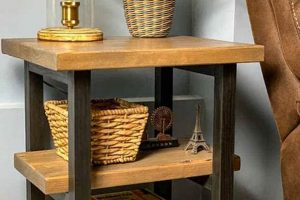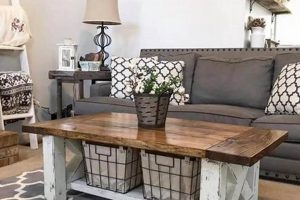A shop-fabricated support structure designed for use with a drill press enhances the functionality and precision of the tool. This user-created platform typically features a flat, stable surface, often constructed from materials like wood or metal, that provides increased workpiece support during drilling operations. It frequently incorporates features such as adjustable fences, miter slots, and clamping mechanisms to improve accuracy and repeatability. For example, a woodworker might construct one to ensure perpendicular holes when building a cabinet.
The significance of this addition lies in its ability to expand the versatility and safety of a drill press. It offers a more stable and controlled environment compared to using the bare drill press table, leading to improved accuracy and reduced instances of workpiece slippage or damage. Historically, these custom additions arose from a need to adapt standard drill presses to specialized or repetitive tasks, reflecting a maker’s resourcefulness in optimizing existing equipment. This also provides for larger work-piece support.
The following sections will explore various design considerations, material choices, construction techniques, and accessory integrations related to optimizing such custom-built platforms. These topics provide a foundation for understanding how to create an effective and personalized drill press workstation.
Enhancing Drill Press Operation
The following guidelines present key considerations for improving the effectiveness and safety of drill press operations through supplementary platforms.
Tip 1: Material Selection. Employ dense, dimensionally stable materials like Baltic birch plywood or hardwood for the primary table surface. This minimizes warping and ensures consistent performance over time. A void-free material will prevent issues during clamping.
Tip 2: Fence Integration. Incorporate an adjustable fence system to provide a reliable reference edge for repetitive drilling tasks. Aluminum extrusion or hardwood can be utilized, and it should be easily repositionable and lockable.
Tip 3: Clamping Solutions. Integrate T-tracks or similar clamping channels to secure workpieces firmly. This significantly reduces the risk of workpiece movement and enhances accuracy. Consider the use of toggle clamps for quick release.
Tip 4: Dust Management. Implement a dust collection port and shroud to manage airborne particles. This improves visibility and maintains a cleaner working environment. A shop vacuum can be easily connected to this port.
Tip 5: Miter Slot Inclusion. Incorporate a standard miter slot to accommodate miter gauges and sliding jigs. This enhances the versatility of the setup, particularly for angled drilling operations. Standard sizes are recommended.
Tip 6: Surface Treatment. Apply a durable finish, such as polyurethane or epoxy resin, to the table surface. This protects the wood from moisture and wear, prolonging its lifespan. Multiple coats are recommended for heavy use.
Tip 7: Reinforcement and Support. Stiffen the underside of the platform with ribs or stringers, particularly for larger tables. This prevents sagging and ensures a rigid, stable surface. Consider using a grid-pattern or a solid backing material.
Adhering to these suggestions results in a more versatile, accurate, and safer drill press workstation, optimizing performance across a range of projects.
The subsequent sections will delve into specific design considerations for implementing these features, allowing for customization based on individual needs and project requirements.
1. Stability
Stability is a foundational requirement for a shop-fabricated drill press platform, serving as a primary determinant of drilling accuracy and operational safety. An unstable platform introduces vibration and movement during drilling, leading to inaccuracies in hole placement and potential damage to both the workpiece and the cutting tool. This instability stems from inadequate structural rigidity within the constructed platform or an insufficient connection between the platform and the drill press itself. Consider a scenario where a user attempts to drill a precise series of holes for dowel joinery on a project; any wobble or vibration in the platform undermines the precision of the pilot hole location, leading to misaligned joints and a compromised final product.
Achieving suitable stability frequently involves strategic material selection and construction techniques. Dense hardwoods or multi-layered plywood offer superior resistance to bending and vibration compared to lighter, less rigid materials. Reinforcement measures, such as adding stringers or ribs to the underside of the table, further augment structural integrity. Proper attachment to the drill press, utilizing bolts and a secure mounting system, is equally critical to prevent movement between the drill press base and the custom platform. A practical example is the integration of a steel frame beneath a wooden table surface to minimize flex during use.
In summary, stability within a DIY drill press table directly influences the quality and safety of drilling operations. Failure to prioritize this attribute compromises precision, potentially resulting in flawed workpieces and increased risk of injury. The effective implementation of robust materials, reinforced construction, and secure mounting mechanisms is essential for maximizing the functionality of a custom-built drill press workstation. These elements ultimately contribute to a safer and more reliable workshop environment.
2. Accuracy
Accuracy is a critical attribute of a shop-fabricated drill press platform. It directly dictates the precision and repeatability of drilling operations. Deviations from intended hole placements compromise the quality and integrity of finished projects. The relationship between the platform and accuracy is causal: deficiencies in platform design or construction directly result in diminished drilling accuracy. The degree to which a platform facilitates accurate drilling determines its overall utility. For example, a platform lacking a precisely aligned fence system will impede the consistent drilling of equally spaced holes, essential in applications like cabinetry or furniture construction.
Improving the accuracy of a shop-fabricated drill press table necessitates incorporating design features that mitigate potential sources of error. An adjustable fence, precisely aligned perpendicular to the drill press spindle, serves as a reliable reference point for consistent hole placement. Miter slots facilitate angled drilling operations with enhanced precision when used with miter gauges. Integrated measuring scales or indexing systems enable the precise positioning of workpieces for repetitive tasks. Furthermore, the surface of the table must be flat and coplanar to ensure the workpiece is consistently supported, eliminating variations that can affect drill bit entry angle.
In summary, accuracy is not merely a desirable characteristic of a shop-fabricated drill press platform; it is a fundamental requirement for producing high-quality, repeatable results. The investment in precise construction techniques, the integration of accurate reference systems, and the attention to surface flatness directly contribute to enhanced drilling accuracy and, ultimately, the successful completion of various woodworking and metalworking projects. Compromising accuracy undermines the purpose of the platform, rendering it significantly less valuable.
3. Workpiece Support
The term “workpiece support,” in the context of a shop-fabricated drill press platform, refers to the table’s capacity to adequately and securely hold a material during drilling operations. Insufficient support leads to vibration, material movement, and inaccurate results. A drill press table is intrinsically linked to workpiece support; its design and features directly determine the stability and control afforded to the material being drilled.
- Surface Area and Table Size
The overall dimensions of the platform dictate the maximum size of material that can be effectively supported. A larger surface area provides greater stability for larger workpieces, preventing tipping or flexing during drilling. Consider the scenario of drilling a large panel for a cabinet; a small drill press table necessitates cumbersome auxiliary supports, increasing the risk of misalignment. A larger, more appropriately sized shop-fabricated table eliminates this issue.
- Table Material and Rigidity
The material composition and inherent rigidity of the table influence its capacity to resist deflection under load. A table constructed from a less dense material will flex and vibrate under the pressure of the drill bit, leading to inaccurate hole placement and potentially damaging the workpiece. Hardwoods or layered plywood provide improved resistance to deflection, translating to more stable workpiece support.
- Auxiliary Support Systems
A shop-fabricated platform often incorporates auxiliary systems that enhance workpiece support. Adjustable fences, for example, provide a consistent reference edge, preventing material creep during drilling. Clamping mechanisms, such as T-tracks and toggle clamps, secure the workpiece firmly to the table, eliminating movement and vibration. These systems collectively contribute to improved accuracy and safety. Imagine attempting to drill a small, round workpiece without clamping; the material is likely to spin, resulting in an off-center hole and potential injury.
- Surface Friction and Material Grip
The surface finish of the table impacts the degree of friction between the table and the workpiece. A smooth, polished surface may allow the material to slide during drilling, while a textured or coated surface provides improved grip. Applying a non-slip coating or incorporating strategically placed rubber pads can significantly enhance workpiece support, particularly when working with slick or irregularly shaped materials.
These elements demonstrate the critical connection between workpiece support and the design of a shop-fabricated drill press platform. Optimizing these aspects through informed material selection, thoughtful design, and the integration of auxiliary support systems results in a more versatile, accurate, and safer drilling environment. Without sufficient workpiece support, even the most precise drill press is rendered ineffective.
4. Clamping Mechanisms
Clamping mechanisms are essential components of a shop-fabricated drill press platform. These devices secure workpieces, preventing movement during drilling operations and enhancing both precision and safety. Their integration directly influences the quality of the final product and mitigates the risk of injury.
- T-Track Systems
T-tracks are recessed channels integrated into the surface of the platform. These tracks accommodate T-bolts and clamping knobs, allowing for the adjustable positioning of hold-down clamps and jigs. An example would be securing a fence parallel to the drill bit for repetitive drilling; the fence is locked into place along the T-track, ensuring consistent positioning of each hole. The implementation of T-track systems expands the versatility of the shop-fabricated platform by enabling the use of a range of clamping accessories.
- Toggle Clamps
Toggle clamps provide a quick and secure method for holding workpieces. Their over-center locking mechanism exerts significant clamping force with minimal effort. A common application involves securing a template to a workpiece for pattern drilling; the toggle clamp holds the template firmly in place, ensuring accurate transfer of the pattern. The speed and ease of use of toggle clamps make them well-suited for repetitive drilling tasks.
- Cam Clamps
Cam clamps utilize an eccentric cam to apply clamping pressure. These clamps are often used for edge clamping or securing workpieces against a fence. For instance, cam clamps can be used to hold a board against a fence during edge drilling. They provide a firm and consistent hold, preventing movement that would otherwise compromise the accuracy of the drilling operation.
- Hold-Down Clamps
Hold-down clamps are designed to exert downward pressure on the workpiece, preventing lifting or vibration during drilling. These clamps are particularly useful for securing thin or flexible materials. An example would be clamping a sheet of plywood to prevent it from vibrating as the drill bit penetrates the material. The use of hold-down clamps minimizes splintering and ensures a cleaner, more accurate hole.
The selection and integration of clamping mechanisms directly impact the effectiveness and safety of a DIY drill press table. A thoughtfully designed clamping system enhances accuracy, reduces the risk of material slippage, and improves overall efficiency in a variety of drilling applications. A poorly executed clamping system negates the benefits of the additional platform.
5. Dust Collection
Effective dust collection is a critical component of a shop-fabricated drill press table, directly impacting operator safety, visibility, and the longevity of equipment. The drilling process inherently generates airborne particulate matter, including wood dust, metal shavings, and plastic fragments. Without adequate dust collection, these particles accumulate in the workspace, posing respiratory hazards, obscuring the operator’s view of the drilling operation, and potentially damaging the drill press motor. For instance, prolonged exposure to fine wood dust is linked to respiratory ailments, while metal shavings present a laceration hazard. A well-designed dust collection system mitigates these risks, contributing to a safer and more efficient work environment.
The integration of dust collection into a shop-fabricated drill press table can take several forms, depending on the scale and nature of the drilling operations. A common approach involves incorporating a dust collection port directly beneath the table surface, connected to a shop vacuum or central dust collection system. This port captures dust and debris as it is generated, preventing it from becoming airborne. An alternative design utilizes a surrounding shroud or enclosure to contain dust within a defined area, enhancing the effectiveness of the dust collection system. This is exemplified by an enclosure constructed around the bit, with a vacuum hose pulling out the debris. The effectiveness of any system depends on proper airflow and the proximity of the collection point to the source of dust generation.
In summary, dust collection is not a superfluous add-on, but rather an integral element of a well-designed shop-fabricated drill press table. Prioritizing dust collection enhances operator safety, improves visibility during drilling operations, and protects the equipment from dust-related damage. While challenges exist in designing and implementing effective dust collection systems, the benefits significantly outweigh the effort involved. A comprehensive approach to dust management is essential for maintaining a clean, safe, and productive workshop environment.
Frequently Asked Questions
The following questions and answers address common inquiries and concerns regarding the design, construction, and utilization of a shop-fabricated drill press platform.
Question 1: What is the optimal material for constructing a sturdy surface?
High-density materials, such as Baltic birch plywood or hardwoods like maple, are recommended due to their dimensional stability and resistance to warping. Avoid using particleboard or MDF for the primary table surface, as these materials are prone to moisture damage and lack the necessary structural integrity.
Question 2: How important is it to have an adjustable fence system?
An adjustable fence system is paramount for achieving accuracy and repeatability in drilling operations. The fence serves as a reliable reference point for consistent hole placement, particularly in applications involving repetitive drilling tasks. It should be easily adjustable and securely lockable to maintain precise positioning.
Question 3: What is the best approach for integrating clamping capabilities?
Integrating T-tracks into the table surface provides a versatile solution for securing workpieces. T-tracks accommodate a variety of clamping accessories, such as T-bolts and clamping knobs, enabling adjustable and secure workpiece fixation. Alternative clamping methods, such as toggle clamps or cam clamps, can also be incorporated based on specific needs.
Question 4: How can dust collection be effectively implemented on the shop-fabricated platform?
Effective dust collection can be achieved by integrating a dust collection port directly beneath the table surface, connected to a shop vacuum or central dust collection system. Enclosing the drilling area with a shroud or barrier further enhances dust containment and collection efficiency. Regular maintenance of the dust collection system is essential to ensure optimal performance.
Question 5: What steps should be taken to ensure long-term stability and durability?
Reinforcing the underside of the table with stringers or ribs provides added structural support, preventing sagging and maintaining surface flatness. Applying a durable finish, such as polyurethane or epoxy resin, protects the wood from moisture and wear, extending the lifespan of the platform. Proper storage and maintenance practices also contribute to long-term durability.
Question 6: Are there any safety considerations specific to shop-fabricated drill press tables?
Prioritize safety by ensuring the platform is securely mounted to the drill press base. Always wear appropriate personal protective equipment, including safety glasses and a dust mask. Before commencing drilling operations, verify the workpiece is securely clamped and that all safety mechanisms are functioning correctly. Avoid reaching across the drill bit during operation.
These FAQs highlight the key considerations for designing and building a safe and effective shop-fabricated drill press platform. By addressing these common questions, users can make informed decisions and avoid potential pitfalls.
The next section will provide a practical guide to a step-by-step approach to creating your own platform.
DIY Drill Press Table
This exploration has underscored the importance of a well-conceived and executed shop-fabricated drill press platform. From the selection of appropriate materials to the integration of essential features such as fences, clamping mechanisms, and dust collection, each element contributes to the overall functionality, accuracy, and safety of the drilling process. The preceding discussion highlighted specific considerations regarding stability, workpiece support, and the practical implementation of various design choices.
The diligent application of these principles empowers the operator to enhance the versatility and precision of standard drill press equipment. It fosters a safer and more efficient work environment, yielding improved results across a range of projects. The ultimate success of a custom-built drill press platform rests on a commitment to sound engineering practices and a thorough understanding of the specific demands of the intended applications. Further investigation and careful execution will allow the operator to reap the benefits of a custom-built station.







